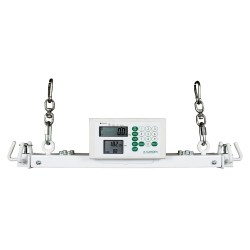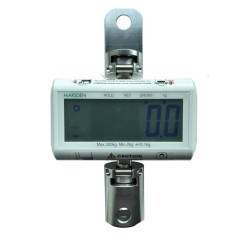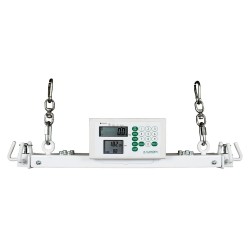Hoist Weighing Scale Attachments
There are 3 products.
Active filters
About Hoist Weighing Scale Attachments
Integrated Weighing During Patient Hoisting Procedures
Hoist weighing scale attachments provide innovative weighing solutions that integrate weight measurement directly into patient hoisting equipment, serving hospitals, care homes, rehabilitation facilities, and healthcare services throughout England, Scotland, Wales, and Northern Ireland. These specialised weighing systems attach to existing patient hoists or comprise weighing mechanisms built into hoist slings, enabling accurate weight measurement during routine patient lifting and transfer procedures without requiring separate weighing equipment or additional patient handling. Healthcare environments utilise hoist weighing attachments for monitoring patients requiring regular hoisting for mobility, tracking weights of immobile patients unable to use conventional scales, managing bariatric patients whose size exceeds standard weighing equipment, supporting palliative care monitoring through minimal-disturbance weighing integrated with care activities, and enhancing efficiency through dual-purpose equipment serving both transfer and weighing functions. Modern hoist weighing attachments incorporate features including high accuracy despite dynamic weighing environments, digital displays readable during procedures, compatibility with standard hoist systems, and appropriate capacities accommodating bariatric patients. The provision of hoist weighing capability ensures comprehensive weight monitoring across all patient populations including those with severe mobility limitations, prevents discrimination by providing accessible weighing for patients unable to use conventional scales, and supports efficient clinical workflow through integration of weighing with necessary care activities across professional healthcare environments.
The implementation of hoist weighing scale attachments directly supports CQC compliance through enhanced patient safety eliminating additional handling solely for weighing, efficient use of care staff time, and demonstration of innovative approaches to clinical monitoring for vulnerable patient groups. Traditional weighing approaches for hoisted patients require two separate procedures: transfers for care or mobility purposes, and additional separate transfers specifically for weighing. This duplication increases manual handling risks for patients and staff, consumes valuable care time often resulting in weighing being deferred or omitted, and causes additional distress for patients undergoing multiple transfers. Hoist weighing attachments address these challenges by combining transfer and weighing in single procedures, eliminating unnecessary patient handling reducing safety risks and distress, enabling convenient frequent monitoring through integration with routine hoisting, and improving workflow efficiency through time savings. Clinical benefits include regular weight monitoring detecting changes indicating illness or nutritional issues, convenient tracking supporting care planning and intervention evaluation, and comprehensive data despite challenging patient populations. Healthcare organisations benefit from reduced manual handling incidents when unnecessary procedures are eliminated, improved weight monitoring data quality when weighing becomes routine rather than exceptional, and enhanced staff efficiency enabling focus on direct patient care. Modern hoist weighing attachments incorporate advanced features including automatic weight hold capturing measurements despite movement, tare functions compensating for sling weight, and wireless data connectivity throughout England, Scotland, Wales, and Northern Ireland.
Selecting and implementing hoist weighing scale attachments requires assessment of existing hoist equipment, appropriate system specification, and integration with care protocols across healthcare facilities throughout the UK. Organisations should evaluate their patient hoist infrastructure determining compatibility requirements and whether retrofitting existing hoists or purchasing integrated hoist-scale systems proves more appropriate, assess patient populations identifying volumes requiring both hoisting and regular weighing, and calculate potential efficiency gains and safety improvements. Equipment selection should prioritise compatibility with existing hoist models unless replacing entire systems, accuracy specifications meeting clinical requirements, appropriate capacity typically up to 300kg or higher for bariatric applications, and user-friendly displays readable during dynamic transfer procedures. Implementation protocols must encompass comprehensive staff training on system operation during transfers including calibration verification, weight reading during lifting, troubleshooting unstable readings, and appropriate documentation. Quality assurance measures should include regular calibration maintaining accuracy, validation against known weights periodically, cleaning and infection control protocols, and monitoring of both weighing accuracy and transfer safety. Modern hoist weighing attachments incorporate features such as large backlit displays visible in varied lighting, wireless connectivity eliminating trailing cables creating trip hazards, and robust construction withstanding clinical use. Organisations should establish clinical protocols identifying patients benefiting from hoist weighing, standardise procedures ensuring consistent technique across staff, integrate weights into electronic records and care plans, and implement processes triggering interventions for concerning changes. Clinical teams should consider specific populations including bariatric patients requiring high-capacity equipment, palliative care patients benefiting from minimal disturbance, and frail elderly patients for whom additional handling poses significant risks. Staff education should emphasise that hoist weighing attachments complement rather than replace standard scales for ambulant patients, maintaining comprehensive weighing capability across varied patient needs. Maintenance protocols should ensure regular servicing of both hoist and weighing components maintaining safety and accuracy. By implementing hoist weighing scale attachments and integrated weighing protocols, healthcare organisations throughout England, Scotland, Wales, and Northern Ireland demonstrate their commitment to CQC standards, innovative care approaches maximising efficiency whilst maintaining safety, patient-centred care through minimised handling and distress, and comprehensive clinical monitoring enabling early detection of changes across vulnerable patient populations whilst supporting staff through efficient dual-purpose equipment reducing workload and manual handling risks.



